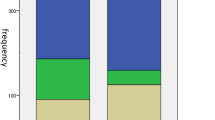Abstract
This study is an attempt to test the predictions made by Chapman and Miller (1975) that (1) productive control of the subject-object relation exceeds comprehension performance based on syntactic form alone, and (2) less linguistically advanced children decode subject-object relations lacking referential support on the basis of a lexical-semantic strategy that assigns animate nouns to subject status and inanimate nouns to object status. Ten children, divided on the basis of mean length of utterance into two groups (average MLU of 2.45 and 3.75, respectively), participated. Comprehension and production of subject-order in semantically reversible sentences with inanimate or animate subject and object was assessed using an object manipulation format. The results obtained provided partial support for the predictions made by Chapman and Miller (1975). The proposed lexical-semantic strategy for comprehension was not employed by the subjects of the present study; these children appeared to use a probable event strategy in determining subject-object assignment. Although productive control of the ordering of subject and object was found to exceed comprehension performance, the facilitating effect of visual cues available during the production trials likely contributed to the observed differences in performance between the two tasks.
Similar content being viewed by others
References
Abramson, A. (1977).Child language: An interdisciplinary guide to theory and research Baltimore: University Park Press.
Baird, R. (1972). On the role of chances in imitation, comprehension and production: Test results.Journal of Verbal Behavior, 11, 474–477.
Bloom, L. (1970).Language development: Form and function in emerging grammars. Cambridge, Massachusetts: M.I.T. Press.
Bloom, L. (1974). Talking, understanding and thinking. In R. Schiefelbusch & L. Lloyd (Eds.),Language perspectives: Acquisition, retardation and intervention. Baltimore: University Park Press.
Bloom, L. (1978). Developmental interaction between understanding and speaking. In L. Bloom & M. Lahey,Language development and language disorders, New York: Wiley.
Bowerman, M. (1974).Early syntactic development: A cross-linguistic study with special reference to Finnish. Cambridge, England: Cambridge University Press.
Brown, R. (1973).A first language: The early stages. Cambridge, Massachusetts: Harvard University Press.
Brown, R., & Fraser, C. (1963). The acquisition of syntax. In C. Cofer & B. Musgrave (Eds.),Verbal behavior and learning: Problems and processes. New York: McGraw-Hill.
Chapman, R., & Kohn, L. L. (1978). Comprehension strategies in two and three year olds: Animate agents or probable events?Journal of Speech and Hearing Research, 21, 746–761.
Chapman, R., & Miller, J. (1975). Word order in early two and three word utterances: Does production precede comprehension?Journal of Speech and Hearing Research, 18, 355–371.
Clark, R., Hutcheson, S., & Van Buren, P. (1974). Comprehension and production in language acquisition.Journal of Linguistics, 10, 39–54.
Cohen, M. (1967). Active and passive language development of grammar.Connecticut College of Psychology Journal, 4, 20–24.
Fernald, C. (1972). Control of grammar in imitation, comprehension and production: Problems of replication.Journal of Verbal Learning and Verbal Behavior, 11, 606–613.
Fraser, C., Bellugi, U., & Brown, R. (1963). Control of grammar in imitation, comprehension and production.Journal of Verbal Learning and Verbal Behavior, 2, 121–135.
Ingram, D. (1974). The relationship between comprehension and production. In R. Schiefelbusch & L. Lloyd (Eds.),Language perspectives: Acquisition, retardation and intervention. Baltimore: University Park Press.
Keeny, T., & Wolfe, J. (1972). The acquisition of agreement in English.Journal of Verbal Learning and Verbal Behavior, 11, 698–705.
Lahey, M. (1974). The use of prosody and syntactic markers in children's comprehension of spoken sentences.Journal of Speech and Hearing Research, 17, 656–668.
Lovell, K., & Dixon, E. (1967). The growth of control of grammar in imitation, comprehension and production.Journal of Child Psychological Psychiatry, 8, 31–39.
McCarthy, D. (1954). Language development in children. In L. Carmichael (Ed.),A manual of child psychology (pp. 492–630). New York: Wiley.
Nurss, J., & Day, D. (1971). Imitation, comprehension and production of grammatic structure.Journal of Verbal Learning and Verbal Behavior, 10, 68–74.
Petretic, P., & Tweney, R. (1977). Does comprehension precede production: The development of children's responses to telegraphic sentences of varying grammatic adequacy.Journal of Child Language, 4, 201–209.
Shipley, E., Smith, C., & Gleitman, L. (1969). A study in the acquisition of language: Free responses to commands.Language, 45, 322–343.
Turner, E., & Rommetveit, R. (1967). The acquisition of sentence voice and reversibility.Child Development, 38, 649–660.
Winer, B. (1971).Statistical principles in experimental design. New York: McGraw-Hill.
Author information
Authors and Affiliations
Rights and permissions
About this article
Cite this article
McClellan, J., Yewchuk, C. & Holdgrafer, G. Comprehension and production of word order by 2-year-old children. J Psycholinguist Res 15, 97–116 (1986). https://doi.org/10.1007/BF01067516
Accepted:
Issue Date:
DOI: https://doi.org/10.1007/BF01067516




